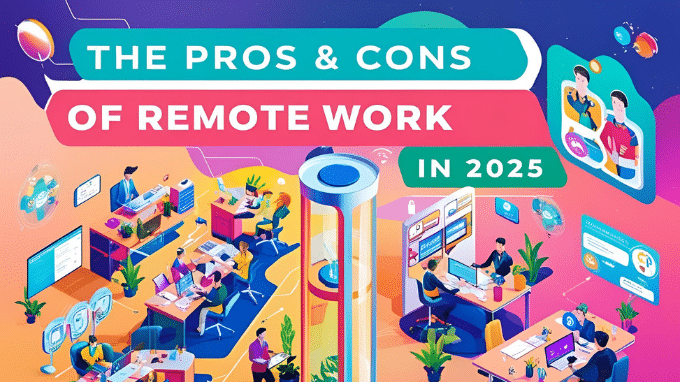The 2025 Remote Work Bombshell: Pros & Cons No One’s Talking About

Remote work isn’t a fad—it’s a $1.3 trillion shift reshaping careers. By 2025, over 36 million Americans will work from home, changing jobs, companies, and how we live. Headlines talk about freedom and balance, but there is a tough side to this change that no one speaks about.
From hidden career risks to unexpected financial perks, the future of remote work is more complex than it seems. Are companies quietly reversing remote policies? Can freelancers really earn more than office workers? And what about the loneliness epidemic?
This guide cuts through the hype, revealing the real pros and cons of remote work in 2025—backed by data, expert insights, and real-world examples. Whether you’re searching for remote jobs in the USA, exploring freelance opportunities, or optimizing your work-from-home setup, this is the unvarnished truth you need to succeed.
6 Game-Changing Benefits of Remote Work in 2025

1. The Salary Revolution
Forget cutting pay due to zip codes. By 2025, top firms will now pay Silicon Valley wages to talent in Tulsa! Skills matter more than big buildings. It gives equal pay to good workers no matter where they live. Big tech companies and new startups lead this change. They make it so top workers can earn a lot, even if they live far from main cities.
- Location-agnostic pay scales are becoming standard at tech-forward companies
- Example: A senior developer in Ohio now earns the same $180,000 as their NYC counterpart
- Freelance premiums: Niche consultants charge 150−400/hour for specialized skills
2. True Schedule Control
Flexibility is now a must for the modern workforce. Companies are changing how they work to bring in and keep staff. Studies show that control over work hours increases both work done and happiness, especially for groups on the edge.
- 4-day workweeks now at 28% of remote companies (Upwork 2024)
- Core hours models (10 am-2 pm) reduce meeting fatigue by 62%
- Best for: Parents, caregivers, and night owls who peak after dark
3. Geographic Freedom 2.0
Remote work opened a new time of “geoarbitrage.” Workers move to get more money and a better life. Now, governments and bosses try to get remote workers with money offers and easy visas.
- Tax arbitrage: Save $12,000+/year by relocating from CA to TX
- Zoom towns like Tulsa offer $10K relocation incentives
- Emerging trend: “Workation” packages from Portugal to Bali
Read next: Are You Underpaid in 2025? Here’s What a Competitive Salary Really Looks Like!
4. The Productivity Paradox
At first, people doubted it. But now, data shows remote workers get more done. Why? Fewer distractions, and they can set up their own space. It turns out, just being present is not the same as doing good work.
- 68% of knowledge workers report higher output at home (Stanford)
- Key factors:
- Fewer office interruptions
- Personalized work environments
- Async communication
5. Career Customization
The rise of working from home has changed the old “one-job identity.” Now, people can mix stable jobs, creative roles, and side gigs. This change lets them turn skills into more ways to earn without feeling too tired.
- Build a “portfolio career” combining:
- Main remote role
- Consulting gigs
- Passion projects
- Example: Marketing director by day, AI prompt coach by night
6. Health & Wellness Wins
Remote work is more than ease—it lifts life quality with clear health perks. Workers go from hating drives to caring for fitness, gaining time for things that count.
- Eliminating commutes saves 200+ hours/year
- Home-cooked meals reduce obesity risk by 23%
- Flexible schedules enable midday workouts/therapy
6 Hidden Dangers of Remote Work in 2025
1. The Proximity Penalty
“Out of sight, out of mind” hurts careers in hybrid jobs. Managers tend to favor those they see in the office. Even if a company says it values remote work, hidden biases still exist. This makes remote workers find ways to stay visible.
- Hybrid workers are 2.3x more likely to get promoted (Harvard)
- Why: Unconscious bias favors visible employees
- Solution: Schedule “office sprints” before reviews
2. The RTO Backdoor
Many firms are slowly pulling back on remote rules with unclear job notes and slow asks. What starts as “choice” days at the office often turns into a must, leaving staff caught off guard.
- 43% of “remote” jobs now include undisclosed office requirements
- Red flags:
- “HQ-adjacent preference”
- “Regular team gatherings”
- “Hybrid trial period”
3. The Isolation Trap
Loneliness has become a hidden problem of remote work, with bad effects on mind and body. Without trying, full-time remote workers may end up feeling alone—even if they get a lot done.
- Chronic loneliness affects 42% of full-time remote workers
- Health impact: Equivalent to smoking 15 cigarettes/day
- Fix: Coworking memberships reduce risk by 61%
4. Benefit Erosion
Remote staff often find their pay and perks aren’t as good as office staff. From health care to bonuses, firms still treat remote workers as lesser employees.
- 29% of remote workers pay more for equivalent healthcare
- Often excluded from:
- Office perks
- Team bonuses
- Stock options
5. Cybersecurity Nightmares
Hackers now target home offices, taking advantage of loose personal networks. Remote workers must guard important data but often lack help from their bosses.
- Home networks are 11x more vulnerable (Verizon)
- Essential protections:
- VPNs
- Password managers
- Two-factor authentication
6. The Async Miscommunication Problem
Without face-to-face cues, online chats often lead to mix-ups. Using async tools too much can hurt teams when subtle hints and context are missing from notes.
- Digital communication causes 52% more misunderstandings
- Worst offenders:
- Ambiguous Slack messages
- Tone-deaf emails
- Meeting-free cultures
Read next: Skill Trends: What Employers Are Looking for in 2025
Myth vs. Reality: The Truth About Remote Work in 2025
Myth 1: Remote Workers Are Less Productive Without Supervision
Reality:
- A 2024 Stanford study tracking 12,000 employees found remote workers were 9% more productive on average
- High-performing remote teams use output-based metrics (completed projects, client satisfaction) rather than hours logged
- Top companies report productivity gains through:
- Fewer unnecessary meetings (saving 4.1 hours/week per employee)
- Reduced office distractions (37% less task-switching reported)
Myth 2: Remote Work Is Only for Tech and Creative Jobs
Reality:
Traditional industries now embracing remote models include:
- Healthcare (27% growth in telehealth administration roles)
- Law (19% of paralegal work now fully remote)
- Finance (16% of accounting positions offer hybrid options)
Fastest-growing remote roles by sector (LinkedIn 2024 data):
- Medical coding (+142% YoY)
- Insurance claims adjusting (+88%)
- HR compliance (+76%)
Myth 3: Building Culture Remotely Is Impossible
Evidence-Based Solutions:
- Asynchronous culture-building practices showing success:
- Weekly video updates from leadership (adopted by 43% of remote-first companies)
- Virtual mentorship programs (improving retention by 31% at Dell)
- Digital “watercooler” channels (Slack/Discord communities with scheduled social hours)
- Quarterly in-person retreats maintain connections (used by 68% of Series B+ startups)
Myth 4: Remote Work Means Constant Flexibility
The Hidden Structure:
- 72% of successful remote workers maintain fixed core hours (10am-3pm most common)
- Top performers establish:
- Dedicated workspaces (92% invest in ergonomic setups)
- Morning routines (63% report this as critical for focus)
- Digital “shutdown” rituals to prevent burnout
Is Remote Work Right for You? A 2025 Self-Assessment
Signs Remote Work Aligns With Your Strengths:
Work Style Attributes:
- Strong self-motivation and time management skills
- Comfort with written communication (emails, docs, chat)
- Ability to troubleshoot technical issues independently
Career Stage Considerations:
Established professionals benefit from:
- Leveraging existing networks remotely
- Higher salary negotiation power
Junior employees may struggle with:
- Limited in-person mentorship opportunities
- Building initial professional relationships
Industries With Strong Remote Potential:
- Best Fit:
- Technology (software development, UX design)
- Knowledge services (consulting, market research)
- Digital marketing (SEO, content strategy)
- Challenging Fit:
- Hands-on healthcare (nursing, dentistry)
- Laboratory sciences
- Manufacturing/quality control
Hybrid as a Compromise Solution:
- When It Works Best:
- Roles requiring occasional collaboration (2-3 office days/week)
- Companies with strong remote infrastructure but cultural ties to physical spaces
- Employees who value:
- Face-to-face brainstorming
- Structured onboarding
- Clear separation between work/home
Read next: Remote Work Salary Trends in 2025
What’s Next For You?

For Those Considering Remote Work:
- Conduct a trial period (1-2 months) to assess personal fit
- Audit your home workspace for:
- Reliable high-speed internet
- Minimal distractions
- Proper ergonomic setup
- Research industry-specific remote trends using:
- LinkedIn’s “Remote Jobs” filter
- FlexJobs industry reports
- Professional association surveys
For Current Remote Workers Seeking Improvement:
- Implement quarterly “visibility audits” to ensure career progression
- Join at least one professional community (e.g., Remote Work Association)
- Schedule annual skill assessments to stay competitive
Winning Strategies for 2025
For Employees: Protect Your Freedom & Accelerate Growth
Remote work freedom is under quiet threat—from hidden rules to favoring those nearby. The best workers aren’t just remote; they’re making sure their careers are safe.
- Negotiate ironclad remote clauses
- Document all achievements meticulously
- Build an “office optional” skill set
For Employers: Win the War for Remote Talent
Top staff now want ease more than fun things at work. Firms that don’t face the hard parts of remote work will lose their best staff to firms that do.
- Audit promotion rates by work location
- Create remote-specific career paths
- Invest in better virtual collaboration tools
Mastering Remote Work in 2025
The new world of remote work brings great freedom but needs smart plans to do well. To succeed now, workers should focus on three key goals: use the freedom of location to save money, know how this impacts taxes, stay visible to leaders even from afar, and set clear limits to avoid burnout when working from home.
Ready to put what you’ve learned into practice and start earning $180,000 remotely? Start applying these remote work tips and inside scoop and take control of your productivity and balance!





